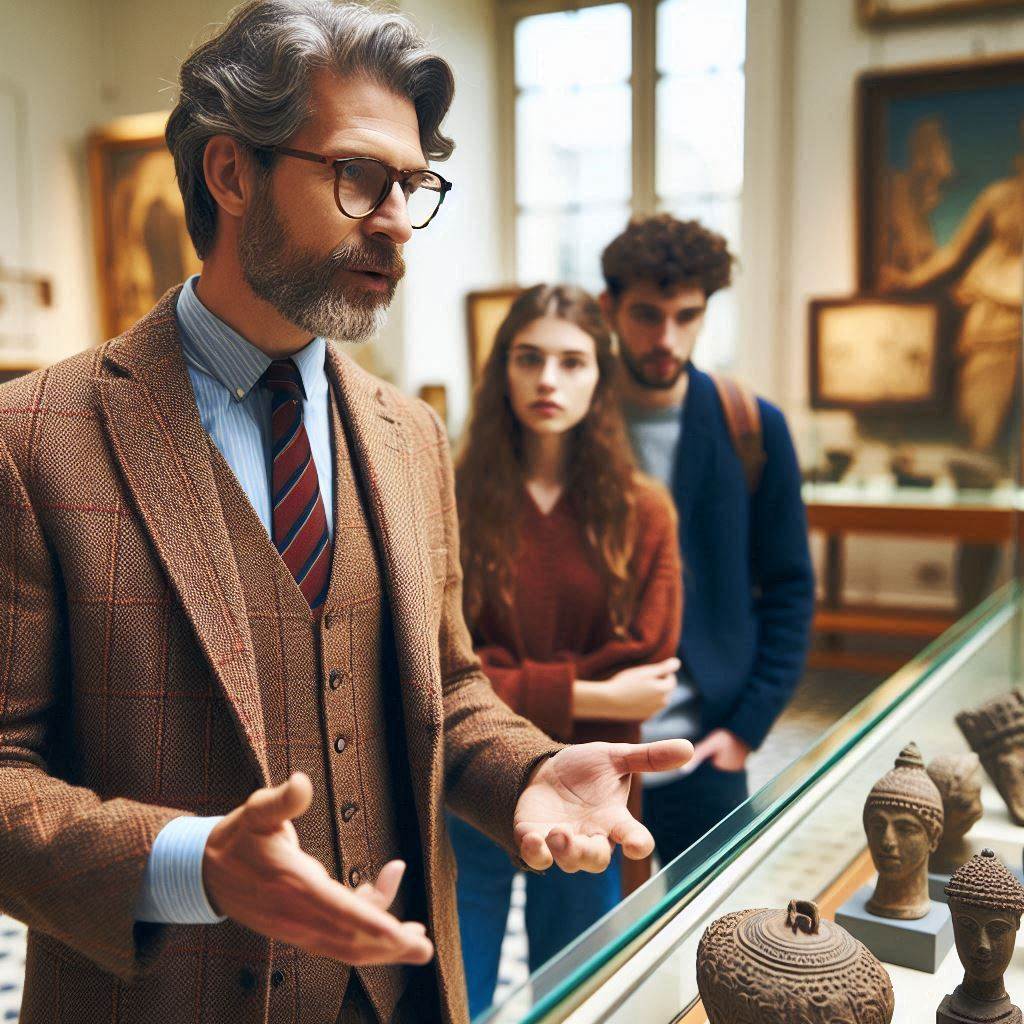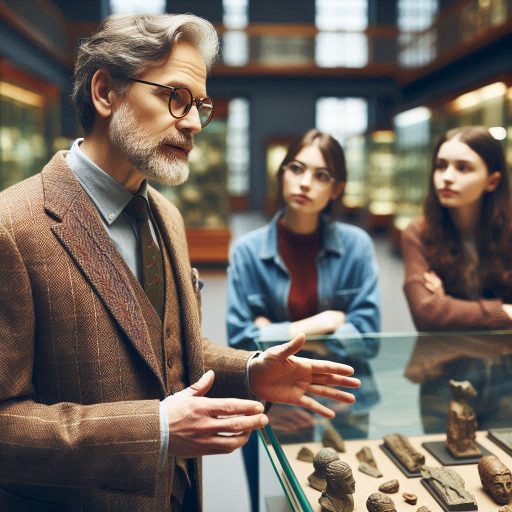Introduction
A museum curator plays a vital role in the world of cultural preservation and education.
They manage collections of artifacts and artworks, ensuring each piece’s safety and accessibility.
Curators conduct thorough research to understand the historical significance of items, providing context that enhances visitors’ experiences.
Their expertise helps create engaging narratives around the collections, fostering a deeper connection between the artifacts and the public.
The importance of a museum curator extends well beyond merely maintaining artifacts.
Curators serve as stewards of history and culture, preserving valuable resources for future generations.
They curate exhibitions that allow audiences to engage with history, art, and culture in meaningful ways.
By presenting artifacts thoughtfully, curators enable visitors to learn about different cultures, historical events, and artistic movements.
This work ensures that we can appreciate and understand our shared heritage.
Curators also play a crucial role in enhancing public engagement.
They design educational programs and interactive exhibitions that resonate with diverse audiences.
By doing so, curators make museums welcoming and relevant spaces for everyone.
This emphasis on education helps to cultivate an appreciation for the arts and history among visitors of all ages.
Research and Acquisition
Curators play a pivotal role in conducting extensive research on artifacts and collections within their museum.
This involves delving into the history, significance, and provenance of each piece to enhance the museum’s understanding of its collection.
By immersing themselves in the study of various artifacts, curators can provide valuable insights that contribute to the overall interpretation and exhibition of these pieces.
Their research sheds light on the cultural, social, and historical contexts surrounding each artifact, enriching the visitor’s experience.
Conducting Research
Curators engage in thorough research to uncover the stories behind each artifact.
This may involve analyzing historical documents, consulting with experts, and utilizing advanced technologies to glean new information.
By deepening their knowledge of these pieces, curators can offer a fresh perspective that resonates with visitors.
Moreover, this research enables curators to identify gaps in the museum’s collection, allowing them to strategize on acquiring new artifacts that complement existing holdings.
It is through this diligent investigation that curators can expand and diversify the museum’s representation of history, art, and culture.
Acquiring New Artifacts
The process of acquiring artifacts for a museum’s collection requires careful consideration and collaboration.
Curators must keep abreast of the art market, attend auctions, and cultivate relationships with collectors, dealers, and donors to source potential acquisitions.
When evaluating potential artifacts, curators assess their authenticity, condition, and relevance to the museum’s mission and collection.
They also consider ethical considerations, such as provenance and cultural sensitivity, to ensure that the acquisitions align with best practices in museum stewardship.
Collaborating with Experts
Curators frequently collaborate with other curators and experts in various fields to gain a more comprehensive understanding of artifacts and collections.
This interdisciplinary approach allows curators to leverage diverse perspectives and expertise to enrich their interpretations and research.
By sharing knowledge and resources with fellow professionals, curators can access specialized information and insights that enhance their scholarly work.
Collaborations with experts in conservation, anthropology, art history, and other disciplines enable curators to explore different facets of their collections and present them in a more nuanced and engaging manner.
Read: Character Design Trends: What’s Hot in 2024?
Collection Management
Cataloging and Documenting Artifacts in the Collection
One of the primary responsibilities of a museum curator is cataloging and documenting artifacts.
Curators meticulously record details about each item in the collection.
This process includes noting the item’s provenance, condition, and significance.
Accurate documentation helps ensure that future generations understand the context of each artifact.
Curators use various database systems to maintain records.
They input information such as the artist’s name, date of creation, and historical relevance.
This organized system allows for easy access and retrieval of information when needed.
Furthermore, curators regularly update records to reflect changes in the collection.
Curators also write descriptions and labels for exhibits.
These labels educate the public about the artifacts, providing essential context.
Effective labeling enhances the visitor experience and fosters a deeper understanding of the collection.
Curators ensure that information is accurate, accessible, and engaging.
Ensuring Proper Storage and Conservation of Artifacts
Another critical responsibility of a museum curator is ensuring proper storage and conservation of artifacts.
Curators develop conservation strategies to protect items from deterioration.
They assess the environmental conditions necessary for preserving different materials.
For instance, curators monitor humidity, temperature, and light levels in storage areas.
Curators collaborate with conservators to implement preservation techniques.
They may recommend specific treatments for damaged items.
This collaboration ensures that artifacts remain in optimal condition for future generations.
Curators also conduct regular inspections to identify potential issues early.
Additionally, curators educate museum staff and visitors about artifact care.
They provide guidelines on handling and displaying items to prevent damage.
By raising awareness, curators foster a culture of respect for cultural heritage.
Proper care not only protects artifacts but also enhances the museum’s reputation.
Managing Loans and Exchanges with Other Institutions
Museum curators also manage loans and exchanges with other institutions.
They negotiate agreements to borrow or lend artifacts for exhibitions.
This process often involves careful planning and communication with other curators.
Curators ensure that all loans comply with legal and ethical guidelines.
They assess the condition of artifacts before and after loans to document any changes.
This attention to detail protects the museum’s interests and maintains the integrity of the collection.
Moreover, curators often participate in temporary exhibitions.
They work with other institutions to create engaging displays that benefit both parties.
These collaborations enhance public access to artifacts and promote cultural exchange.
Basically, museum curators hold essential responsibilities in preserving and promoting cultural heritage.
They catalog and document artifacts, ensure their conservation, and manage loans with other institutions.
Through these key tasks, curators contribute significantly to the educational mission of museums and the preservation of history.
Read: How to Price Your Ceramic Artwork
Exhibition Planning
Developing Exhibition Concepts and Themes
A museum curator plays a crucial role in developing exhibition concepts and themes.
They begin by researching various subjects and trends relevant to their institution.
Curators analyze audience interests and community needs to ensure relevance.
This research informs their decisions on topics that resonate with visitors.
They also consider the museum’s mission and existing collections when formulating ideas.
Once a concept is established, curators outline the exhibition’s narrative.
This narrative guides the overall design and presentation of the exhibition.
Creating compelling themes involves interdisciplinary collaboration.
Curators often engage with historians, artists, and educators to enrich their ideas.
They may conduct workshops or brainstorming sessions to generate diverse perspectives.
This collaboration ensures that the exhibition is both informative and engaging.
Curators also stay updated on current trends in the museum field.
This ongoing education helps them create innovative and appealing exhibitions.
Selecting Artifacts for Display
Selecting artifacts for display is a critical responsibility for museum curators.
They meticulously evaluate the items in the collection to identify relevant pieces.
This process involves assessing the historical significance, condition, and provenance of each artifact.
Curators also consider how artifacts contribute to the exhibition’s narrative and theme.
Once curators identify suitable artifacts, they may consult with other experts.
These experts can provide insights into the artifacts’ context and significance.
Curators must also ensure that selected items align with the museum’s mission.
They prioritize diversity in their selections to represent various perspectives and cultures.
After finalizing the artifacts, curators collaborate with conservators to prepare items for display.
This preparation may include cleaning, restoring, or repairing artifacts to ensure their longevity.
Curators also document the condition of each item for future reference.
This careful selection process ultimately enhances the educational impact of the exhibition.
Collaborating with Designers and Exhibition Teams to Create Engaging Exhibitions
Collaboration is essential for museum curators when creating engaging exhibitions.
Curators work closely with exhibition designers to bring their vision to life.
They share their ideas and objectives, ensuring that the design reflects the exhibition’s theme.
Designers then create layouts that maximize visitor engagement and flow.
Curators also collaborate with educators and marketing teams to promote the exhibition.
They develop educational materials that accompany the display, enhancing visitor understanding.
These materials may include brochures, interactive guides, or digital content.
By involving various departments, curators ensure a cohesive experience for visitors.
Additionally, curators oversee the installation of the exhibition.
They coordinate the placement of artifacts, signage, and interactive elements.
This hands-on involvement ensures that the exhibition meets their conceptual vision and educational goals.
After the exhibition opens, curators continue to evaluate visitor feedback.
They use this information to make improvements for future exhibitions.
Therefore, museum curators play a vital role in developing exhibition concepts, selecting artifacts, and collaborating with teams.
Their efforts ensure that exhibitions are engaging, informative, and accessible to diverse audiences.
Read: Top Skills Needed for a Successful Character Designer

Education and Outreach
Developing Educational Programs for the Public
Museum curators play a vital role in developing educational programs that engage and inspire the public.
They design programs to make museum exhibits accessible to all age groups.
These programs can include interactive displays, lectures, and hands-on activities that enhance the visitor’s understanding of art, history, or science.
By creating meaningful educational experiences, curators help visitors form connections with the exhibits, fostering a deeper appreciation for cultural heritage.
Curators also adapt their programs to meet the needs of diverse audiences, ensuring accessibility for people with varying interests and educational backgrounds.
Transform Your Career Today
Unlock a personalized career strategy that drives real results. Get tailored advice and a roadmap designed just for you.
Start NowOrganizing Tours and Workshops for Visitors
Curators are responsible for organizing tours and workshops that provide deeper insight into the museum’s collection.
They work with guides and educators to plan tours tailored to different age groups and learning levels.
These tours can focus on specific themes or time periods, offering visitors an enriched understanding of the exhibits.
In addition, workshops often accompany these tours, providing hands-on experiences that further enhance learning.
For example, curators may design art-making workshops related to a specific exhibit, encouraging visitors to explore their creativity.
By organizing these activities, curators actively engage the public and promote a lifelong love of learning.
Collaborating with Schools and Universities for Educational Initiatives
Museum curators often collaborate with schools and universities to create educational initiatives that support academic curricula.
They work closely with teachers and professors to design programs that align with classroom learning objectives.
These collaborations may include field trips, specialized tours, and workshops that complement what students are learning in school.
Curators also develop educational materials and guides that help teachers integrate museum visits into their lesson plans.
By partnering with educational institutions, curators provide students with hands-on learning experiences that enhance their understanding of art, history, or science.
In addition to working with local schools, curators may collaborate with universities on research projects or public lectures.
These partnerships allow curators to contribute to academic research while making museum collections more accessible to students and educators.
Collaborating with higher education institutions also provides curators with opportunities to introduce new scholarship and research into their museum’s programming.
This relationship benefits both the museum and the academic community, ensuring that exhibits remain relevant and educational.
Museum curators are key to developing engaging educational programs, organizing insightful tours and workshops, and fostering collaboration with educational institutions.
Their efforts make museums a valuable resource for public learning and ensure that exhibits are accessible and meaningful to diverse audiences.
Through these initiatives, curators promote education, creativity, and curiosity, enriching the visitor experience and contributing to lifelong learning.
Read: Career Paths in Ceramic Art and Design
Conservation and Preservation
Implementing Conservation Techniques to Preserve Artifacts
Museum curators play a crucial role in safeguarding cultural heritage by implementing advanced conservation techniques.
Their primary goal is to preserve artifacts, ensuring these treasures endure for future generations.
They assess the condition of artifacts and determine the most appropriate methods to prevent deterioration.
This involves using specialized equipment and techniques, such as cleaning, stabilizing, and repairing damaged items.
By employing non-invasive techniques, curators minimize the risk of further damage, maintaining the integrity of each artifact.
Curators also collaborate with conservators, who specialize in various types of materials, from textiles to metals.
Together, they develop strategies that protect delicate objects from environmental threats.
These conservation efforts require an understanding of the artifact’s historical context, material composition, and potential vulnerabilities.
In many cases, curators must prioritize which artifacts receive immediate attention based on the severity of damage or risk factors, making quick decisions essential to the artifact’s survival.
Monitoring Environmental Conditions in Storage and Exhibition Spaces
Another key responsibility of a museum curator is monitoring environmental conditions.
Artifacts are sensitive to changes in temperature, humidity, and light exposure.
Even slight fluctuations in these factors can accelerate deterioration.
Curators continuously monitor and adjust conditions in both storage and exhibition spaces to maintain optimal settings for preservation.
For example, keeping humidity levels too high can cause mold, while low levels can dry out delicate materials.
To manage these conditions effectively, curators use climate control systems and data loggers to track changes in the environment.
These systems provide real-time data, allowing curators to react quickly to any deviations from the ideal settings.
In exhibition spaces, curators may install UV filters to minimize light exposure, especially for photos, textiles, and other light-sensitive materials.
Balancing public access to artifacts with their long-term preservation is a central challenge for curators.
Developing Conservation Plans for Long-Term Preservation of Artifacts
Long-term preservation requires meticulous planning, and museum curators are instrumental in developing conservation strategies.
These plans outline preventive measures that ensure the preservation of artifacts over many years.
Curators conduct regular condition assessments to identify any emerging issues.
Based on these assessments, they create detailed conservation plans that address both immediate and long-term needs.
A key component of these plans is the selection of appropriate storage materials and methods.
Acid-free boxes, specialized shelving, and archival-quality enclosures protect artifacts from environmental factors and physical damage.
Additionally, curators often implement rotational display schedules to limit the exposure of fragile items to potentially harmful conditions.
By rotating collections, curators reduce wear and tear, extending the lifespan of sensitive artifacts.
Overall, museum curators ensure that preservation techniques, environmental monitoring, and strategic planning are seamlessly integrated to protect cultural heritage.
Through their efforts, artifacts are preserved in pristine condition, allowing future generations to appreciate their historical significance.
Cultural Representation
Representing the Museum at Conferences and Events
Museum curators play a key role in representing their institutions at conferences and events.
They actively engage with industry professionals, sharing the museum’s work and insights on collections.
By attending these events, curators stay informed about the latest trends and research in the museum sector.
They often participate in panels, deliver presentations, and contribute to discussions that highlight the museum’s contributions to cultural heritage.
This active participation elevates the museum’s reputation and fosters connections with other professionals in the field.
Building Relationships with Cultural Organizations and Institutions
Building relationships with cultural organizations and institutions is a crucial responsibility for museum curators.
They collaborate with art galleries, historical societies, and universities to exchange knowledge and resources.
These partnerships lead to joint exhibitions, educational programs, and research projects that enrich the museum’s offerings.
Curators also work to establish long-term relationships, ensuring future collaboration and access to rare artifacts and expert insights.
These alliances enhance the museum’s network, bringing valuable opportunities for growth and collaboration.
Advocating for the Importance of Museums and Cultural Heritage
Curators are passionate advocates for the importance of museums and cultural heritage.
They communicate the value of preserving historical and cultural artifacts to the public, government officials, and educational bodies.
Curators lead initiatives that raise awareness about the role museums play in preserving history and educating future generations.
By advocating for funding, policy support, and public engagement, curators help secure the future of museums.
Their efforts ensure that museums remain vital spaces for learning, creativity, and community connection.
Conclusion
Museum curators play a crucial role in preserving our cultural heritage through various key responsibilities.
They are responsible for acquiring, documenting, preserving, and interpreting the objects in a museum collection.
Museum curators conduct research and organize exhibitions.
They collaborate with other professionals to create engaging displays.
Their goal is to share the museum’s collection with the public in an educational way.
Recap of key responsibilities of a museum curator
Some key responsibilities of a museum curator include acquiring, documenting, preserving, and interpreting museum collections.
They also conduct research, plan exhibitions, and collaborate with other professionals.
Importance of museum curators in preserving and sharing cultural heritage
Museum curators play a vital role in preserving and sharing our cultural heritage.
They ensure proper maintenance, documentation, and display of artifacts.
This work allows present and future generations to appreciate and learn from these objects.
Call to action for supporting museums and curators in their work
It is important to support museums and curators in their work by visiting museums, participating in events, donating, and advocating for the importance of preserving our cultural heritage.
By supporting museums and curators, we can ensure that our cultural legacy is preserved for future generations.
[E-Books for Sale]
The Big Book of 500 High-Paying Jobs in America: Unlock Your Earning Potential
$19.99 • 500 High-Paying Jobs • 330 pages
Explore 500 high-paying jobs in America and learn how to boost your career, earn more, and achieve success!
See All 500 High-Paying Jobs of this E-Book
1001 Professions Without a Degree: High-Paying American Jobs You Can Start Now
$19.99 • 1001 Professions Without a Degree • 174 pages
Discover 1001 high-paying jobs without a degree! Unlock career tips, skills, and success strategies for just $19.99!




